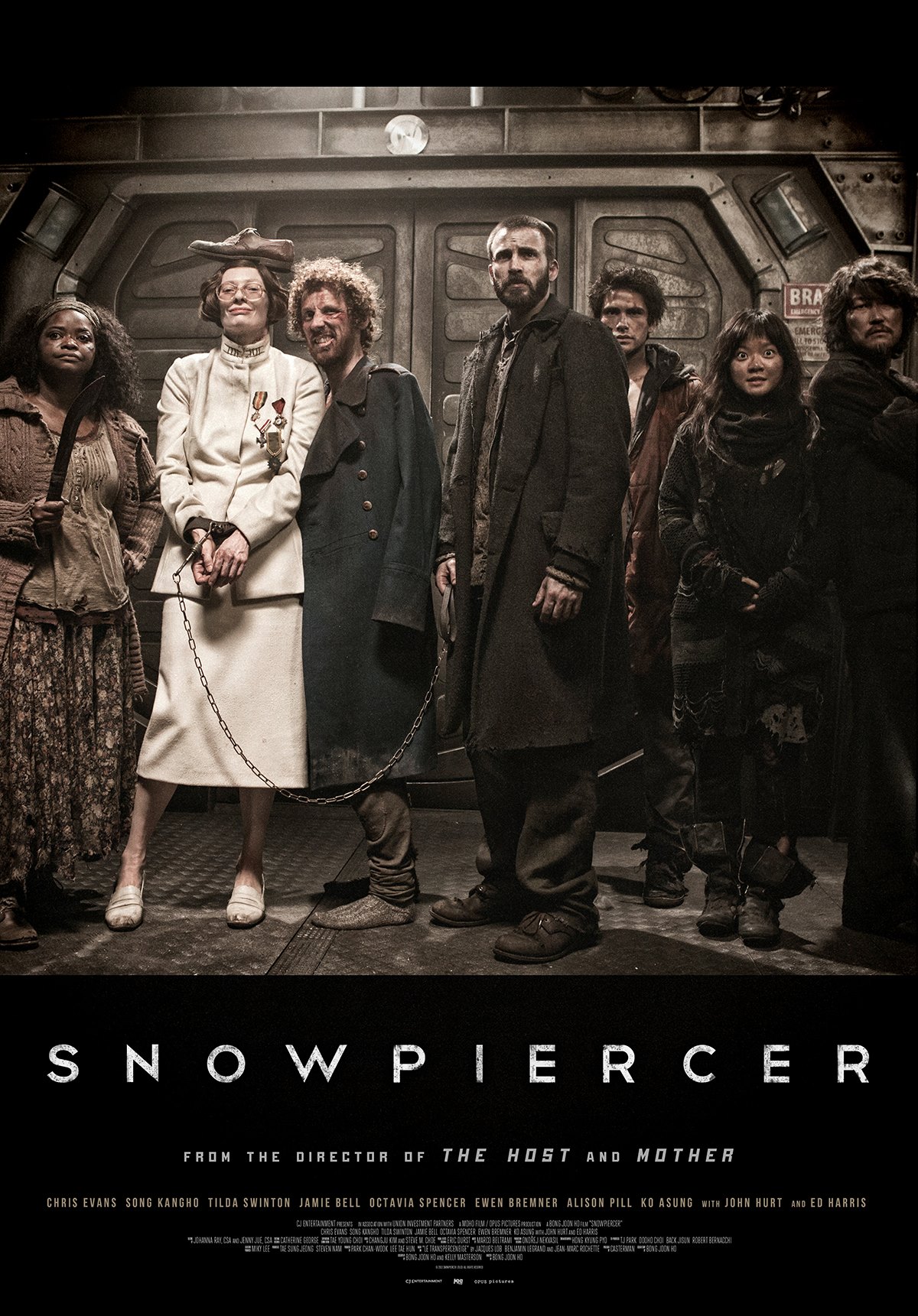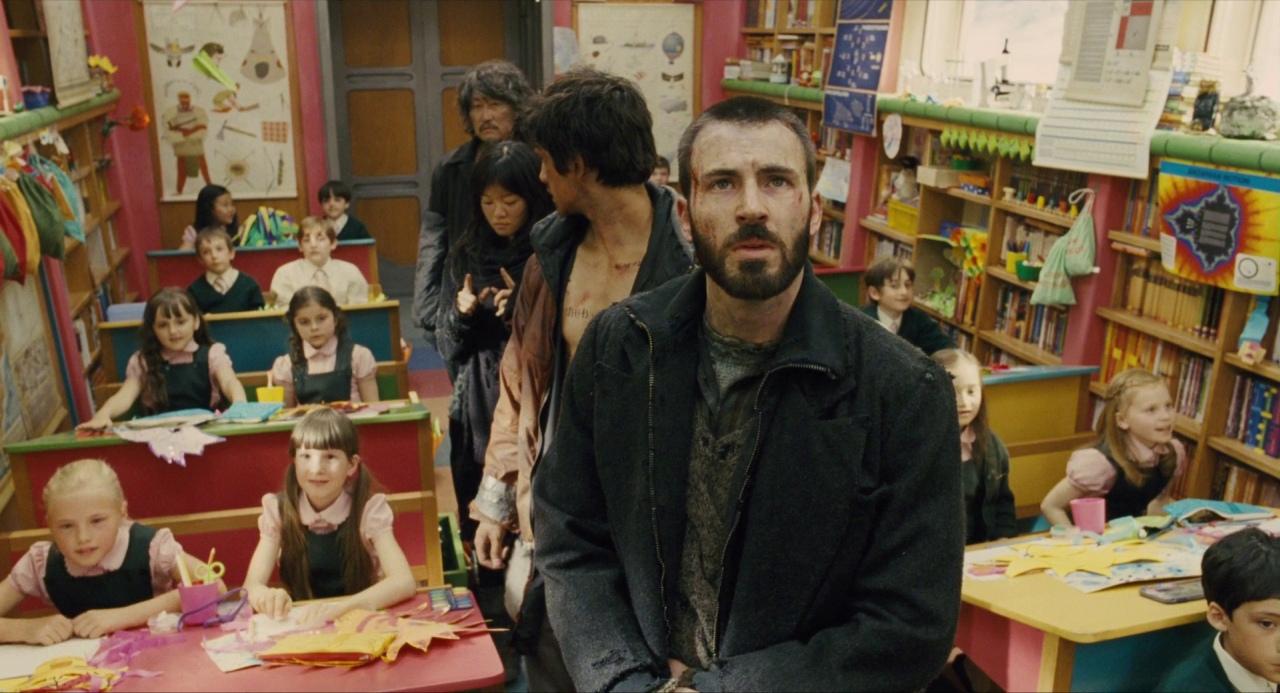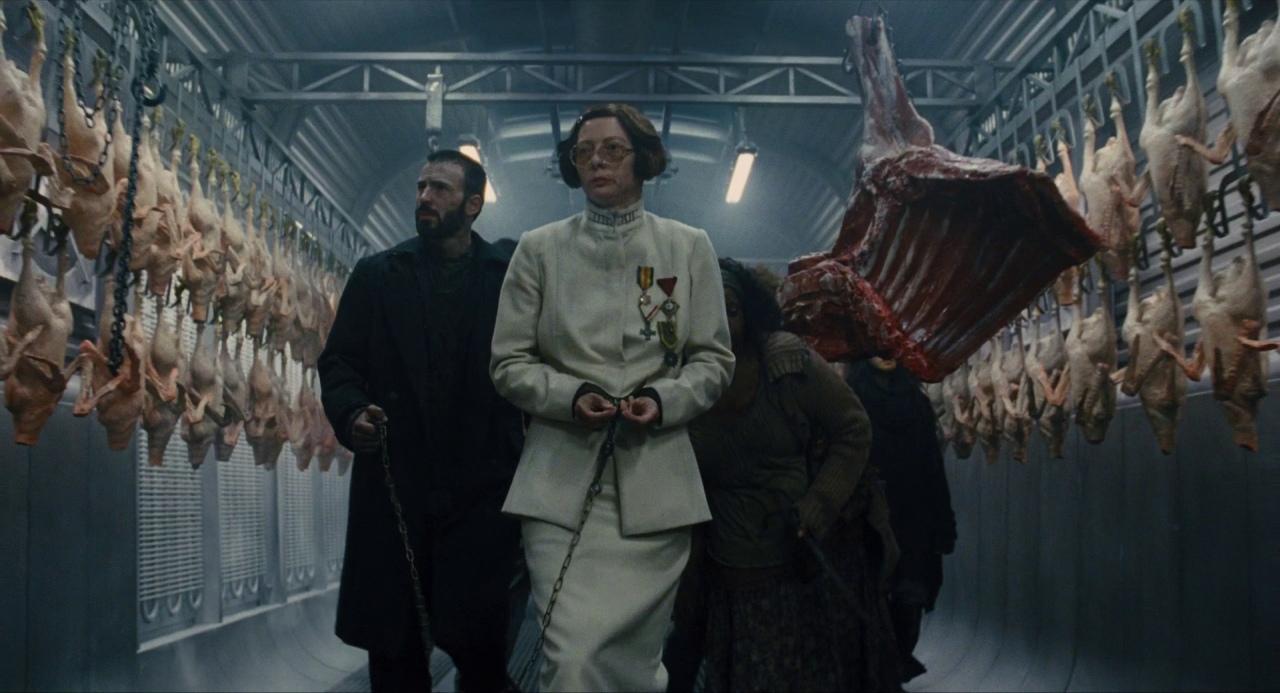

“Old world people were friggin’ morons who got turned into popsicles.”
Two crucial things must be acknowledged when discussing Snowpiercer, Bong Joon-ho’s stupefying English-language debut.
The first point is that its premise is absolutely ludicrous. Well, perhaps that’s a bit too strongly stated. I suppose it’s half-plausible, as in, I could definitely envision the government bungling a large-scale effort to counteract climate change so badly that the entire globe plunges into an ice age. That idea could kick off a hard sci-fi story just as easily as a hokey one and would feel entirely credible. No, what I refer to as ludicrous is the untenable conceit that the only humans who survived the cataclysm are those that boarded a self-sustaining train that now endlessly circumnavigates the globe, driven on by a perpetual engine designed by an eccentric inventor, who, in the seventeen years since his newfangled Noah’s Ark saved the human race, has ascended to the rank of demigod, fanned into flames a folk religion centered upon his Wizard of Oz–like persona, and arbitrarily asserted a rigid social structure over the passengers.
In the beginning, order was prescribed by your ticket: first class, economy, and freeloaders like you. Eternal order is prescribed by the Sacred Engine. All things flow from the Sacred Engine. All things in their place, all passengers in their section, all water flowing, all heat rising, pays homage to the Sacred Engine, in its own particular preordained position. So it is. Now, as in the beginning, I belong to the front. You belong to the tail. When the foot seeks the place of the head, the sacred line is crossed. Know your place. Keep your place. Be a shoe.
That’s cartoon villainy, to be sure, and segues nicely to the second point, which is that, despite the film’s overt, barely-allegorical approach, the caste system employed here has no real world analog. In fact, it makes little sense even within the context of the film’s weakly-drawn world. Consider the train’s economic system (or lack thereof), wherein the poor souls living atop one another in the back cars, eating bug bars and whiling away their days in misery, serve basically no purpose whatsoever. Occasionally, due to a faulty part that cannot be replaced in the “Sacred Engine,” one of the raggamuffin children is poached by a lady in a bright yellow coat (Emma Levie) and taken to the front to work for Wilford (Ed Harris), the savior of mankind. But put yourself in Wilford’s shoes for a moment. Does an occasional need for a child laborer justify dragging thousands of people around the globe who do nothing but machinate to commandeer your train? Of course not.

I understand the compulsion to stick up for the little guy and take the empathetic angle, but if you’re trying to paint the front-car elites as callous and exploitative, at least have them, you know, exploit something. To be clear, then, the train is emphatically not a microcosm of the real world, even if it has its heartstring-tugging moments that jibe with one’s inner Good Samaritan. It is also not a metaphor for capitalism. And that’s just a single plothole among many1 that gets at the crux of the matter: that the story is insultingly contrived at all points and that this constant hamfisted grandstanding is to the film’s ultimate detriment. If anyone’s being exploited, it’s the undiscerning viewer.
This essential imbalance between faux-realism and simplistic allegory holds in almost all facets of the film and severely undercuts its value as purely escapist entertainment (which could have been its saving grace). Consider the action sequences, which are put together quite nicely in spots. Whenever the peasants, led by Curtis (Chris Evans) and Namgoong Minsoo (Song Kang-ho), launch their forward attacks, the violent clashes play out with a weird mixture of shaky cam intensity and laughably incoherent character movements, as if logic was employed only selectively. In some shots the skirmishes are utter chaos, in others the choreography is nonchalant. As the insurgents battle their way up the train, moving from their grimy lodgings through the protein bar factory, the greenhouse, the aquarium, the sushi bar, the meat locker, the schoolhouse, the hair salon, the sauna, the rave, there is no sense that the train is an organized institution, let alone a self-sustaining ecosystem. In the earlier sequences, legions of soldiers had made their way to the back to antagonize the bottomfeeders and protect the authority figures that had come to torment them. They show up only sporadically thereafter, but somehow their bruised and bloodied retreat fails to faze the noncombatant upper crusters who continue to enjoy their luxuries even as the rear-enders invade. It is almost as if Bong and co-writer Kelly Masterson occasionally forgot that the novelty of the train setup meant that things could only move in one direction if you start from one end and go to the other.

In any case, Curtis, Namgoong, Edgar (Jamie Bell), Gilliam (John Hurt), Tanya (Octavia Spencer), Yona (Ko Asung) and company gradually hack their way through car after car of rich jerks only to discover that this is just a less compelling remix of The Matrix Reloaded; that Wilford pre-ordained Curtis to make it all the way to the front car, and so on and so forth. If the allegory held any merit to begin with, it’s destroyed by the film’s conclusion which, while narratively daring (in a non-narrative-driven film), suggests that it is better to destroy what resources we have if they cannot be equitably distributed.
If there is a bright spot, it is the film’s pitch black sense of humor. Nowhere is this more clear than the amusingly grotesque performance from Tilda Swinton as Minister Mason. Nearly unrecognizable behind make-up, glasses, nasty dentures, and a thick Yorkshire accent, Swinton is simply mesmerizing, delivering her lines with just the right balance between sincerity and hilarity. She steals every scene she’s in and in the process almost justifies the entire enterprise. When she’s taken captive by the insurgents and her self-preservative instincts surface, she acts increasingly strange in the face of death, encapsulated in a bizarre moment when she removes her false teeth to suggest… what? That she’s a frail old woman who deserves mercy? That she will perform sexual favors for Curtis? Who knows, but it’s a sublimely hilarious moment and typical of Swinton’s zany portrayal of a character originally written to be a man (and who gets called “sir” multiple times, if I’m not mistaken).
Anyway, the basic problem with Snowpiercer is that it tries to bring too much political baggage on board a dystopian train that barely has the horsepower to make a serviceable fantasy. It modulates between self-serious and goofy, and would have fared much better if it had given more attention to the latter, because the blunt allegorizing is silly.
1. Why did Wilford create a train with built-in slums? Would the poor really have started eating their young before trying to revolt? Would old men really have had the gumption to chop off their own arms to feed the young cannibals? Would this really have forced a change of heart? How is the railroad maintained? Why does the train need to keep moving at all? How did Wilford overlook such a crucial design flaw that he needs small children to mangle their hands by functioning as literal cogs in the machine? Are we really to believe that Gilliam became a double amputee as part of a cover story simply to manipulate Curtis? Why is Yona randomly clairvoyant? The entire thing is only vaguely coherent fantasy.